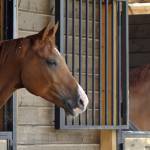Horse Bedding Choices to Suit Every Stable

Bedding is loose, removable material placed on the floor of a stall where an animal is kept. Horse bedding comes in many types, each with various advantages and disadvantages.
When a horse stands in the stall, bedding creates a cushion between the stall floor and the horse’s hooves, reducing fatigue. Bedding provides warmth, reduces floor-level drafts, and keeps the horse from being bruised when lying down. Most bedding is absorbent, soaking up urine and other fluids. Finally, bedding protects the floor of the stall from moisture and wear.
The optimal amount of bedding to use depends to some extent on what sort of flooring is in the stall, with hard or slippery surfaces requiring more bedding. As a general rule, you should spread bedding such that you can’t see or feel the floor as you walk around the stall. Fastidious horses that choose one “toilet corner” may get by with less, while old or sick horses that lie down frequently will be more comfortable with a thicker layer.
Several types of bedding are commonly used, and each has good and bad features.
Straw is the dried and baled stems of harvested wheat, barley, or oats. It is one of the oldest and most traditional bedding materials. Advantages: makes a comfortable bad; often using in foaling stalls because it won’t stick to horses or clog a foal’s nostrils; used straw can sometimes be sold to mushroom farmers. Disadvantages: sold in large heavy bales, so storage and handling may be difficult; not very absorbent; may be expensive or in short supply in some areas; may be dusty or moldy; some horses eat straw bedding, risking impaction; harder to clean than some other beddings.
Using old hay, often left over from the previous year’s supply, is a fairly common practice. This material has many of the same advantages and disadvantages as straw. It is quite likely to be dusty; horses will probably eat some of it; and it may be contaminated with animal urine or droppings, a possible source of diseases such as EPM. On the other hand, it’s already been paid for and delivered, and probably needs to be used before new hay can be stored.
Sawdust, shavings, and processed or compressed wood products are popular bedding materials in many places. Advantages: widely available; absorbent; pine has pleasant odor and appearance; shavings are less dusty than hay or straw; not edible; very easy to clean the stall; can be bought by the bag or by the truckload; easily handled and transported in small quantities. Disadvantages: sawdust may contain fine particles that irritate the respiratory tract; must be properly stored to stay dry; source must be reliable to exclude metal shreds and other debris; must not contain black walnut products which cause laminitis; wet sawdust clings to coats; shavings are hard to brush out of manes and tails.
Shredded newsprint, recycled cardboard, and compressed paper productsare available in some areas. Advantages: soft; absorbent; fairly easy to clean stalls; free from mold and dust, and therefore good for horses with respiratory problems; not likely to be eaten; can be composted. Disadvantages: horses may be sensitive to ink; light-colored horses may have coat staining from newsprint; easily blown around by wind when dry, but heavy and clumpy when wet.
Peanut hulls and rice hulls are attractive choices if they are locally available. Peanut hulls may contain aflatoxin, which is toxic if ingested. As with most bedding materials, a dry storage area is necessary.
Kenaf, a creamy-tan natural plant fiber, is porous and spongy. It has a low lignin and high cellulose content. It is not available in all areas, and some horses may eat it.
Hemp, either shredded or pelleted, is comfortable, dust-free, easily cleaned, and absorbent, and it composts well. Used in Canada where its cultivation is legal, it must be imported for use in the United States, an expensive complication.
Peat moss is virtually dust-free, absorbent, and easy to compost. It is available by the bag or truckload. A dry storage area is needed for bulk shipment.
Keep these things in mind when selecting the right bedding for your horses:
Cost, availability, and storage. These factors must be considered together. Investigate sources; talk to suppliers and other horse owners in your area abut the pros and cons of locally available bedding choices; think about dry, convenient storage of bedding at your facility.
Handling. Can you most easily manage small bags or larger bales, or do you have the equipment to move bedding stored in bulk?
Disposal. Manure and wet bedding should be picked out several times a day, and stalls should be stripped of all bedding material at regular intervals, depending on how much time the horses spend inside. Soiled bedding can be composted (you need time and space to maintain a composting operation), spread on fields (requires a tractor and manure spreader; check local laws, parasite considerations, and impact on ground water), sold (if there’s a market), or hauled away (can be expensive). Take disposal into account when selecting bedding.
Horse health and comfort. Though listed last, these factors should always be the first concern! Consider day and night temperatures, barn construction and ventilation, how often the stall will be cleaned, and how much time the horse will spend in the stall. When horses are stalled the majority of the time, rubber or dense closed-cell mats can be placed under other bedding materials to provide extra cushioning. Also take into account the condition of the horse’s respiratory tract. Mold, ammonia fumes, and dust can be harmful to any horses, but are especially troublesome for horses with respiratory disease or extreme sensitivity to irritants. These horses should be removed from the barn while stalls are being cleaned and rebedded, and non-allergenic bedding products should be chosen to minimize problems.








